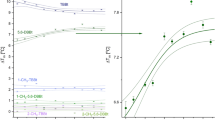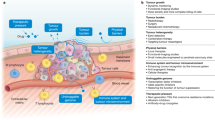Abstract
Anti-cancer agents that have been made selective for tumour cells by exploiting the known differences in the availability of oxygen between normal and transformed cells are a promising development in cancer chemotherapy1. We have recently suggested a new type of bioreductive activity which would depend on a two-electron reduction2–4. For rational design of such compounds, it is essential to be able to predict the redox potentials and the chemical modifications needed to produce the optimum redox value. Calculating redox potentials is a daunting task for the theoretician, however, as the effect of water solvation is clearly of major significance. Recent successful calculations5–10 of differences in the free energies of biologically important molecules in aqueous solution using the free-energy perturbation method prompted us to apply (he technique to the computation of two-electron redox potentials. The results are accurate to within 20 mV, suggesting that we should be able to manipulate redox potentials by successfully predicting structures with the appropriate value.
This is a preview of subscription content, access via your institution
Access options
Subscribe to this journal
Receive 51 print issues and online access
$199.00 per year
only $3.90 per issue
Buy this article
- Purchase on Springer Link
- Instant access to full article PDF
Prices may be subject to local taxes which are calculated during checkout
Similar content being viewed by others
References
Adams, G. E. & Stratford, I. J., Biochem. Pharmac. 35, 71–76 (1986).
Reynolds, C. A., Richards, W. G. & Goodford, P. Anti-Cancer Drug Design 1, 291–295 (1987).
Reynolds, C. A., Richards, W. G. & Goodford, P. J. chem. Soc. 551–556 (1988).
Burridge, J. M., Quarendon, P., Reynolds, C. A. & Goodford, P. J., J. molec. Graphics 5, 165–166 (1987).
Cieplak, P., Singh, U. C. & Kollman, P. A. Int. J. quant. Chem. QBS14, 65–74 (1987).
Wong, C. F. & McCammon, J. A. J. Am. chem. Soc. 108, 3830–3832 (1986).
Singh, U. C., Brown, F. K., Bash, P. A. & Kollman, P. A., J. Am. chem. Soc. 109, 1607–1614 (1987).
Bash, P. A., Singh, U. C., Brown, F. K., Langridge, R. & Kollman, P. A. Science 235, 574–575 (1987).
Bash, P. A., Singh, U. C., Langridge, R. & Kollman, P. A. Science 236, 564–568 (1987).
Rao, S. N., Singh, U. C., Bash, P. A. & Kollman, P. A. Nature 328, 551–554 (1987).
Kennedy, K. A., Teicher, B. A., Rockwell, S. & Sartorelli, A. C. Biochem. Pharmac. 29, 1–8 (1980).
Zwanzig, R. W. J. chem. Phys. 22, 1420–1426 (1954).
Postma, J. P. M., Berendsen, H. J. & Haak, J. R., Faraday Symp. Chem. 17, 55–67 (1982).
Tembe, B. L. & McCammon, J. A. Computers Chem. 8, 281–283 (1984).
Lybrand, T. P., McCammon, J. A. & Wipff, G. Proc. natn. Acad. Sci. U.S.A. 83, 833–835 (1986).
Jorgensen, W. L. & Ravimohan, C. J. chem. Phys. 83, 3050–3054 (1985).
Singh, U. C., Weiner, P. K., Caldwell, J. W. & Kollman, P. A. AMBER Version 3.0 (Dept Pharmaceutical Chemistry, Univ. San Francisco, 1986).
Roothaan, C. C. J. Rev. mod. Phys. 23, 69–89 (1951).
Møller, C. & Plesset, M. S., Phys. Rev. 46, 618–622 (1934).
Dewer, M. J. S. & Stewart, J. J. P., AMPAC, Quantum Chemistry Program Exchange Bulletin 6, 24 (1986).
Clark, W. M., Oxidation-Reduction Potentials of Organic Systems (Balliere, Tindall & Cox, London, 1960).
Jorgensen, W. L., Chandrasekhar, J., Madura, J., Impey, R. W. & Klein, M. L. J. chem. Phys. 79, 926–935 (1983).
van Gunsteren, W. F. & Berendsen, H. J. C. Molec. Phys. 34, 1311–1327 (1977).
Weiner, S. J. et al. J. Am. chem. Soc. 106, 765–784 (1984).
Weiner, S. J., Kollman, P. A., Nguyen, D. T. & Case, D. A. J. comput., Chem. 7, 230–252 (1986).
Singh, U. C. & Kollman, P. A. J. comput. Chem. 5, 129–145 (1984).
Frisch, M. Gaussian 82 Revision H Version (Carnegie-Mellon University, Pittsburg, 1985).
Amos, R. D. CADPAC 3.0 (University of Cambridge, 1986).
Binkley, J. S., Pople, J. A. & Hehre, W. J. J. Am. chem. Soc. 102, 939–947 (1980).
Hariharan, P. C. & Pople, J. A. Theor. chim. Acta 28, 213–222 (1973).
Author information
Authors and Affiliations
Rights and permissions
About this article
Cite this article
Reynolds, C., King, P. & Richards, W. Computed redox potentials and the design of bioreductive agents. Nature 334, 80–82 (1988). https://doi.org/10.1038/334080a0
Received:
Accepted:
Issue Date:
DOI: https://doi.org/10.1038/334080a0
This article is cited by
-
Synthesis, characterization, and X-ray crystal structures of copper(II) and nickel(II) complexes with two bis(thiosemicarbazone) ligands and investigation of their electrochemical behavior
Transition Metal Chemistry (2016)
-
The comparative investigation on redox property and second-order nonlinear response of Keggin-type α-[PM12O39NPh]3− (M = W and Mo) and Mo6NPh
Science Bulletin (2009)
-
Molecular geometry, vibrations and electrode potentials of 2-(4,5-dihydroxy-2-methylphenyl)-2-phenyl-2H-indene-1,3-dione; experimental and theoretical attempts
Journal of Molecular Modeling (2008)
Comments
By submitting a comment you agree to abide by our Terms and Community Guidelines. If you find something abusive or that does not comply with our terms or guidelines please flag it as inappropriate.



